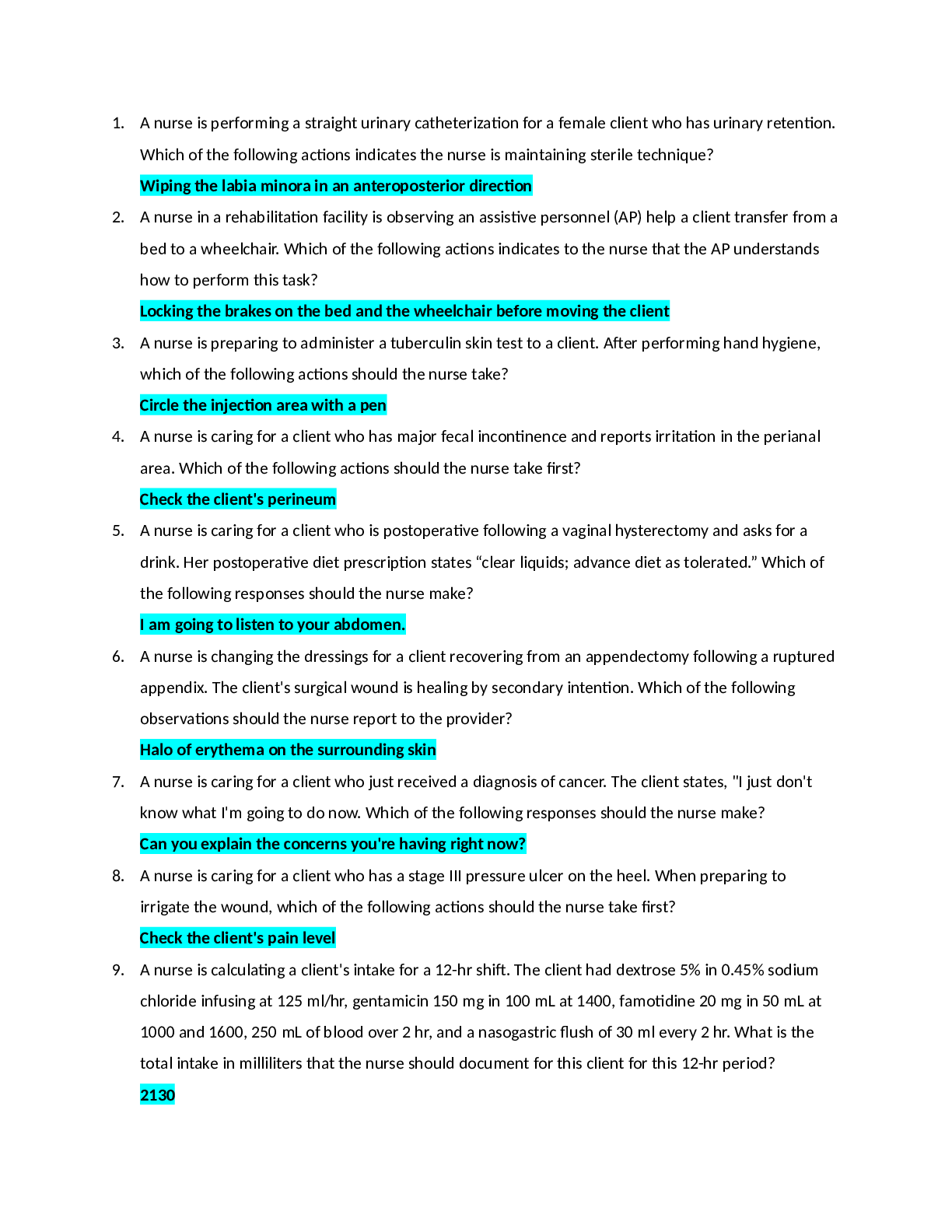*NURSING > EXAM > NR 603 Predictor Exam – 332 Questions with Answers | 100% Correct Solutions | Download To Score An (All)
NR 603 Predictor Exam – 332 Questions with Answers | 100% Correct Solutions | Download To Score An A
Document Content and Description Below
Question: A 15 years old high school student with a mild sore throat and low-grade fever that has persisted for about 3 weeks. She reports general malaise, fatigue, and loss of appetite. The NP suspec... ts mononucleosis. Which of the following is the LEAST appropriate intervention? Question: A 32 years old male patient complaint of urinary frequency and burning on urination for 3 days. Urinalyses reveals bacteriuria and positive nitrites. He denies any past hx. Of urinary tract infections. The initial treatment should be: Question: Which agent is most effective for the treatment of nodulocystic acne? Question: An 18 y/o woman is taking a combined hormonal oral contraceptive. She should be instructed to use a backup method for the prevention of pregnancy Question: A 44 years old female patient has diabetes. Her total cholesterol (TC) is 250 mg/dl (6.5 mmol/L), LDL= 190 mg/dL (4.94 mmol/L), HDL= 25 mg/dL (65 mmol/L), and triglycerides= 344 mg/dL (8.94 mmol/L). What agent have the greatest effect on improving her lipid profile and reducing morbidity and mortality associates with dyslipidemia? Question: A 30 years old female comes into a clinic with classic signs and symptoms of The NP fails to refer the patient to a surgeon. The appendix ruptures and the woman die. This is an example of Question: A NP has recently been hired to work in a fast track The NP employer asked if she has “a problem prescribing medications for emergency contraception.” The NP replies affirmatively. This is: Question: A patient presents with pruritic lesions on both knees. There are visible silver scales. How Should this condition be managed? Question: Antidepressant discontinuation syndrome is less likely if the patient Question: Patient with benign prostatic hyperplasia (BPH) should be taught to avoid which one of the following drug classes? Question: Which of the following is the best response to a woman who has just admitted she is a victim of spousal abuse? Question: For which patient group does the US Preventive Services Task Force recommend routine screening for asymptomatic bacteriuria Question: What diabetic complications result from hyperglycemia? Question: A 6 y/o presents w/ complaints of sore throat and fever for 2 days. He has multiple vesiculated ulcerations on his tonsils and uvula. There are no other remarkable findings. What is the most likely diagnosis? Question: A patient has Kawasaki syndrome. Which characteristics would be UNUSUAL? Question: According to the JNC 8 guideline hypertension in a 40 y/o can be diagnosed when blood pressure exceeds Question: A 48 y/o female complains of pain and stiffness in her right hip and knee that is mild on awakening in the morning, get worse as the day progresses and is relived with hot baths and ibuprofen. Crepitus is palpated on range of motion of the knee. Signs of inflammation are notably absent. What is the most likely diagnosis? Question: A 7-year old female patient presents with severe injuries that are inconsistent with the explanation given for them. The nurse practitioner questions the mother about abuse. She admits that her husband, the child’s father, beat the child. How should the nurse practitioner proceed? Question: A 1-month-old presents with reported recurrent diarrhea, screaming, and drawing up of the legs followed by periods of On physical examination, a “sausage-like” mass in the upper right quadrant of the distended abdomen. Which of the following is the most likely diagnosis? Question: A middle-aged female complains of insomnia, night sweats, feeling intensely hot, emotional lability, extreme nervousness and impatience. The LEAST likely cause of her symptoms is Question: Which of the following indicated need for further evaluation? Question: A young couple is being seen by the NP for preconception They express a wish for pregnancy within the next 3 month and are very eager to know what they can do now to “make the baby as healthy as possible”. Which of the following should the NP encourage to decrease the chance of neural tube defect in the fetus? Question: A patient with a past history of documented coronary arterial blockage less than 70% complains of chest pain several time p…. which is relived with nitroglycerin. Which is the most appropriate initial action for the NP? Question: A 3 y/o has enlarged, warm, tender cervical lymph nodes, indicating: Question: The NP examines a 2-month-old with unequal gluteal and thigh skin folds. What should the NP do next? Question: A very active 35 years old male has painful hemorrhoid, but he does not want hemorrhoidal surgery at this time. His diet has been indiscriminate as his job requires frequent travel. The most appropriate recommendation is for him to select food that are: Question: Correct instructions to give new parent who are transporting their newborn infant is Question: A 13 y/o pt. complains that he fell while running during football practice. Now his knee hurts and sometimes “lucks”. The NP conducts McMurrays test. Which of the following is TRUE about this test? Question: A 20 y/o male patient complains of “scrotal swelling”. He states his scrotum feels heavy but denies pain. On examination, the NP notes transillumination of the scrotum. What is the most likely diagnosis? Question: A 15 y/o male has a hx of cryptorchidism which was surgically repaired. Because of this information, it is essential for the NP to teach him about Question: A pt. present with classic symptoms of gastroesophageal reflux diseases’ (GERD). He is instructed in lifestyle modification, and drug initialed. Two month later, he returns and report that he still has symptoms. The next steps are Question: A 51 –year- old post-menopausal female, request guidance regarding osteoporosis Question: The NP would be correct to recommend all of the following EXCEPT Question: Moderate weight loss, particularly of visceral adipose tissue in patients with type 2 diabetes mellitus may have all of the following beneficial effects EXCEPT: Question: A 12 y/o presents with eat pain or 36 hours The NP diagnoses acute otitis media because the Question: The NP should instruct the mother of an infant with thrush to: Question: A 26 y/o patient, 18 weeks pregnant with twins, has been healthy and has followed recommendations of her nurse midwife. She is in the office to discuss results of her maternal serum alpha-fetoprotein (MSAFP) test. which show elevation in this particular pregnancy? Question: The hallmark of neurofibromatosis (von Recklinghousen disease) present in almost 100% of patients is: Question: The NP correctly teaches an elderly patient with pernicious anemia that food sources of B12 include Question: An 18-year-old female applying for college admission present to the health clinic because evidence of rubella vaccination is required for admission. She says, “don’t remember ever getting that shot” She has negative serologic evidence of rubella antibody. The NP should: Question: A 45 y/o obese pre-menopausal female complains of indigestion, flatulence, RUQ pain and epigastric “crampy pain”. Symptoms are exacerbated by high-fat meal. What is the most likely diagnosis? Question: A 16 y/o male presents w/ mild sore throat, fever, fatigue, posterior cervical adenopathy, and palatine petechia. With for this patient, what drug would be the LEAST appropriate to prescribe? Question: A characteristic of delirium that is typically absent in dementia is Question: It is imperative that the NP teach patients taking oral contraceptives to report any of the danger signs of complications. Which of the following would be the LEAST concern to the NP? Question: Which of the following oral medications should be avoided in a child under 8 years of age? Question: Which of the following descriptions of Denver II Developmental Screening Test is most accurate? Question: A 12-month-old has conjunctivitis in his right eye with a mucopurulent discharge. The mother asks if the child can forego for antibiotic eye drops because he does not’s like drops in his eyes. The NP replies that: Question: Which oral hypoglycemic agent would be safest for an elderly patient if hypoglycemia is a major concern? Question: The components of the Denver II Developmental screening test are: Question: A patient has been taking fluoxetine (prozar) since being diagnosed with major depression 7 month ago. She reports considerable empowerment in her symptoms and her intention to discontinue the medication what should be the NP’s recommendation? Question: For the general adult population, total dietary fat intake should be no more than what percent of total calories? Question: A 30 y/o female patient is being seen by the NP for the first time. She is seeking advice from the NP about becoming pregnant. She is currently taking an oral contraceptive. She gives a hx of having hydatidiform molar pregnancy 2 years ago. An appropriate plan of care for this Question: Which of the following is NOT a goal for treatment for the patient with cystic fibrosis? Question: A 24 y/o female taking oral contraceptive has missed her last 2 pills. What should the NP advise her to do to minimize her risk of pregnancy? Question: Which red blood cell (RBC) index is most useful for differentiating types of anemias? Question: What is a Tzanck test used to diagnosed? Question: A 40 y/o female with hx. Of frequent sun exposure present with multicolored lesion on her back it has irregular borders and is about 11 mm in diameter. What should the NP suspect? Question: A 16 y/o sexually active female presents to the clinic. She has never had vaccinations for hepatitis A or She has had one MMR immunization, and her last tetanus vaccination was 4 years ago. which vaccination would be contraindicated without further testing? Question: Following the finding of prostate gland abnormalities on DRE, The NP orders appropriate labs. When preparing to review with the patient, the NP knows all of the following are true EXCEPT Question: In which of the following presentations is further diagnostic testing NOT warranted? Question: A 59 years old post-menopausal woman has atrophic vaginitis. She has a hx. Of breast cancer at age 40 years. What is the appropriate initial treatment for this patient? Question: Advances in obstetric and neonatal care have which of the following physical modalities recommended for treatment of rheumatic arthritis provides the most effective long-term pain relief? Question: The NP is counseling a 25 y/o sexually active male patient about condom use, which of the following statement is INCORRECT Question: A patient with moderate persistent asthma will probably be most effectively managed with daily Question: Diagnosis of systemic lupus erythematosus (SLE) is made Question: Which of the following would not be considered a developmental red flag to a NP assessing a 4 y/o? Question: A 44 y/o patient complains of stuffiness and soreness in his hands, hips and knees. There is noticeable PIP and DIP joint enlargement in his hands.. The NP suspects arthritis. All of the following questions are helpful in differentiation between rheumatoid arthritis (RA) and osteoarthritis (OA) EXCEPT Question: An adult presents w/ tinea corpus. What comment by the patient would be the LEAST likely explanation of how he acquired this disease? Question: Acute rheumatic fever is diagnosed using the modified Jones criteria. Which is NOT a major criterion in the Jones System? Question: A pt is taking an ACE inhibitor for the blood pressure control. The NP decides to add a diuretic which of the following is the best choice? Question: Acute rheumatic fever is diagnosed using the modified Jones criteria. Which is NOT a major criterion in the Jones System? Question: A pt is taking an ACE inhibitor for the blood pressure control. The NP decides to add a diuretic which of the following is the best choice? Question: Which of the following drugs classes would be most effective in decreasing elevated triglycerides levels (650 mg/dL)? Question: The mother of a 16 y/o high school student athlete is concerned that her daughter has not had a menstrual period yet. on physical examination, the NP finds normal growth and development including appropriate secondary sexual characteristics what is the most appropriate NP action? Question: Factors known to be associated with early sexual activity Question: The finding which is most consistent with a diagnosis of benign prostatic hyperplasia is digital palpation of prostatic gland that is Question: The NP correctly diagnoses iron deficiency anemia in a female patient whose lab report reveals Question: Strabismus is observed in a 13-month-old child. The most appropriate action for the NP to take Question: Giving appropriate patient education by the primary care provider, poor compliance with medical recommendations is most often due to: Question: The physical exam findings in an infant are most effected by which item listed below? Question: Babies should begin oral iron supplementation: Question: The most common cause of cerebral palsy is Question: A patient with diabetes bring his glucose dairy from the past 7 days for the NP to review and evaluate what changes should be made? DAY 1234567 AM 67, 52, 61, 48, 39, 68, 70 PM138, 161, 148, 168, 171, 142, 176 Question: Which of the following patient is at highest risk of suicide? Question: A 17 y/o male is brought into the clinic by his mother who says that is there are no medical consequences or risk known, she will allow her son to get a possible. How should the NP respond? Question: A diagnostic finding of Hodgkin’s lymphoma is the presence of: Question: A child with type 1 diabetes mellitus brings in a glucose dairy indicating consisted morning hyperglycemia. How you differentiate the Somogy effect from the dawn phenomenon? Question: Practitioners working with physically active girls need to be aware of the “female athlete triad” in order to develop an effective pain for prevention, recognition and treatment. the components of the female athlete triad are: Question: Palpable thyroid nodule is benign. How does it feel on palpation? Question: A 53 y/o postmenopausal female with a 38 BMI and gastric esophageal reflux disease, takes a daily calcium supplement for protection against osteoporosis. All of the following are appropriate teaching points for this patient, except Question: A 65 y/o immunocompetent man with no underlying medical condition presents in mid- October and request the “flu and pneumonia shots” Records show he received the influenza and PCV13 ten month ago. The NP recommends that he Question: When discussing treatment option with a patient. The NP would be correct to say that surgery can be curative for: Question: A patient has developed blood clot in his lower extremity and is receiving warfarin (Coumadin) Which outpatient laboratory measurement best measures the therapeutic effect of warfarin? Question: A female patient asks, “how do I calculate my ideal body weight?” The NP appropriately answers: Question: Which term most accurately describes the prostate gland of patient with prostate cancer? Question: Ideally, ante-partum care should begin: Question: Which of the following must be present for the diagnosis of bacterial vaginosis? Question: The patient Self Determination Act of 1991 requires all health care agencies receiving Medicare or Medicaid funds to give patients written information about their rights to make decisions regarding their medical care. A document which declares in advance what type of medical care a person wants … he provided or withheld should he or she be unable to express his or her wishes is called: Question: Thalassemia should be included in the differential diagnosis of an infant with microcytic anemia when the infant’s parents are of what ethnicity? Question: What is the earliest age that MMR immunization can be administered? Question: A male patient with chronic atrial fibrillation takes a genetic brand of Coumadin (Warfarin). He should report all of these to his health care provider EXCEPT Question: Which of the following is not an appropriate treatment for chronic bacterial prostatitis (CBP)? Question: A new patient presents to the NP clinic stating she wants a second She started propiluracil (PTU, Propyl Thyracil) 75 mg 3 times a day a week ago as therapy for newly diagnosed Grave’s disease. She still feels irritable and jittery. How should the NP response? Question: A 15 y/o patient has a complaint of vaginal discharge. She is sexually active with multiple partners. Which of the following symptoms should lead the NP to suspect pelvic inflammatory disease (PID)? Question: Which of the following is NOT a component of the fetal biophysical profile? Question: Which murmur is associated with radiation to the neck? Question: When examining a pregnant patient, where should the fundal height be at 22 weeks? Question: Education of women with fibrocystic breast disease should include which of the following statement Question: An 18 y/o college student lives in the dormitory. He has been treated for scabies infestation with permethrin (Nix). He was asymptomatic for 2 weeks but now complains again of itching and skin burrows. How should the NP proceed? Question: An 83 y/o has heart failure (HF) . He takes Prinivil (lisinopril), metoprolol (Lopressor), ASA, and low dose furosemide every morning. After assessing the patient today, the NP determines that he is having a mild exacerbation of HF (heart failure) the LEAST likely cause of this Question: Antibiotic administration has been demonstrated to be of little benefit in the treatment of which of the following disease process? Question: Which of the following is a medication or medication class that does NOT have dizziness or vertigo as potential adverse side effect? Question: The NP CORRECTLY teaches an insulin dependent patient the signs and symptoms of early hypoglycemia, which include Question: The most effective treatment for a non-infective bursitis included Question: Tunner’s syndrome present exclusively in Question: Once a competent patient is identified as a victim of domestic violence Question: A 60 y/o female patient complains of sudden unilateral, stabbing, surface pain in the lower part of her face lasting a few minutes, subsiding and then returning. The pain is triggered by touch or temperature extremes. Physical examination is normal. The patient had a negative dental examination. CT scan is normal. Erythrocyte sedimentation rate (ESR) is normal. Which of the following is the most likely diagnosis? Question: A 45-year-old pre-menopausal female complains of indigestion, flatulence RUQ and epigastric “crampy pain” that radiates to the right scapula. Symptoms are exacerbated by a high fat meal. What is the most likely diagnosis? Question: Sings and symptoms of anemia, regardless of the specific cause or type, include all of the following EXCEPT: Question: Advance directives are: Question: The CAGE, MAST and AUDIT questionnaires to detect problem drinking should be used: Question: Which of the following scenarios in a 75 y/o patient would be inappropriately managed in an outpatient setting (i.e. the patient should be referred for a hospital admission? Question: An adult female present with a hordeolum. A topical antibiotic is prescribed. Which of the following instructions is NOT appropriate for the nurse practitioner to give the patient? Question: The cornerstone of treatment for stress fracture of the femur or metatarsal stress fracture is Question: Group A Beta hemolytic streptococcal (GABHS) pharyngitis is most common in which age group? Question: Which of the following is NOT a component of CAGE questionnaire? Question: A 62 years old female has been diagnosed with osteoporosis. She refuses hormone replacement therapy as well as new medication shown to increase bone Important education for this patient should include: Question: The NP wants to assess intactness of a patient cerebral function. Which of the following clinical test will provide information relative to cerebral function? Question: The most appropriate medications for elderly patients A 66 y/o female presents to your clinic. She states that yesterday evening she has chest pain for 20-30 minutes. Which finding most strongly correlates with myocardial infarction? Question: The NP is evaluating a 35 y/o female nurse. She has a history of hospitalization for hepatitis B infection 2 years ago. Her laboratory test demonstrates positive HBsIg. The nurse practitioner would most likely diagnose: Question: A 55 y/o male patient complains of blood in his urine for the past 2 weeks. He denies dysuria. Urinalyses is positive for red blood cells and negative for leukocytes and nitrates. The initial evaluation of this patient should include: Question: A good sunscreen lotion or sunblock may contain all of the following components. Which provides the LEAST protection against the sun’s harmful rays? When examining 5 years old the NP knows that this is an appropriate age to teach the child about: Question: A mother presents with her 12-year-old son who has chills, fever, headache, malaise, and myalgias. On examination the NP finds an erythematous lesion, 7.5 cm diameter, with annular edges and central clearing. The boy first noticed the lesion when he was preparing to go back home from a 2-week summer camp in the mountains. Of the following, which is the most likely diagnosis? Question: A NP is holding a prenatal nutrition class for a group of patients. Considering knowledge about cultural variations, which of the following women may be at increased risk for inadequate calcium intake? Question: Which behavior would NOT be expected of a 2 y/o? Question: A 49 years-old Hispanic female has a blood pressure of 145/95 mmHg during a routine annual evaluation. She has no previous history of hypertension. She takes a statin for dyslipidemia. How should the NP proceed with this patient? Question: A 37 y/o female patient with a history of a single episode of depression and frequent complaints of PMS is being treated for hypothyroidism. Today she complains of poor concentration and fatigue. Initially the NP should: Question: When a patient presents with symptoms of acute gallbladder disease, what is the appropriate Question: The client with iron deficiency anemia should be advised to take the iron supplement Question: A 2-week-old infant presents with projectile vomiting, weight loss, dehydration, constipation and history of insatiable appetite. An olive shaped mass is palpable to the right epigastrium. The NP, suspecting pyloric stenosis, refers the infant for an upper GI series. The expected finding is: Question: Which of the following diagnostic assessment must be considered before developing any plan of care for a 27-year-old female presenting to a family practice clinic? Question: An 8 y/o is sent home from school with mucopurulent discharge from his eye. He is brought to the NP for treatment. What is the most appropriate intervention? Question: The NP would be correct to tell a 27 y/o newly diagnosed hypertensive patient that: Question: A 50 years old patient has abnormal vaginal bleeding with heavy periods and intermenstrual watery discharge with a small amount of blood. What is the most likely diagnosis? Question: Which choice below is NOT a symptom of COPD? Question: Therapeutic international normalized ratio (INR) for a patient taking warfarin (Coumadin) for chronic atrial fibrillation is expected to be: Question: A healthy 50-year-old patient presents to the clinic for a routine physical examination. He has no significant personal or family history of clinical heart disease. What should be part of his CV assessment? Question: The NP is initiating levothyroxine (Synthroid) for primary hypothyroidism in a 71-year- old female. The usual starting dose of levothyroxine is 50 (0.05 mg) to 100mcg (0.100mg) per What would be the most appropriate initial therapy in this patient? Question: An example of an indirect role of the nurse practitioner is: Question: In July 1996, the Advisory Committee on Immunization Practices (ACIP) of the Centers for Disease Control and Prevention (CDC) issued which of the following recommendations for the use of the live attenuated varicella vaccine? Question: A patient presents with a furuncle in his right The NP should prescribe an oral antibiotic and: Question: What is the most common chronic condition in the elder population in the S? Question: A 7-year-old male presents with a painless limp, antalgic gait, muscle spasm, mildly restricted hip abduction and internal rotation, proximal thigh atrophy, and slightly short stature. The most likely diagnosis is: Question: A 73-year-old presents with a very sore, glossy, smooth, beefy-red tongue. This clinical presentation most likely reflects: Question: All patients with renal calculi should be taught that the best prevention is: Question: A patient complains of “very puffy feet” since beginning a new medication 3 months There is no underlying physiological cause for this condition. Which medication is most likely causing the problem? Question: The diagnosis of human papilloma virus (HPV) infection in males is usually made by: Question: A patient that has 20/80 vision acuity can see: Question: The reason beta-adrenergic blockers should be avoided in patients with diabetes is because they may: Question: A 73-year-old patient has HTN, CHF, and atrial fibrillation. The patient’s adult daughter phones the NP to report that her mother has been nauseated for several days and has vomited for the past 18 hours. She is confused but has no other neurological deficits. The NP should: Question: A 27-year-old female patient with epilepsy is well controlled with phenytoin (Dilantin). She requests information about contraception. The NP should instruct her that: Question: An 18-year-old female applying for college admission presents to the health clinic because evidence of rubella vaccination is required for admission. She says, “I don’t remember ever getting that shot.” She has negative serologic evidence of rubella The NP should: Question: A 44-eyar-old patient has a dark multi-colored mole on his back which is about eight millimeters in diameter and has an irregular border. The NP should: Question: The typical description of a tension headache is: Question: A 48-year-old female presents with a chief complaint of insomnia. On further investigation, she reports fatigue, nervousness and agitation during the daytime, and feeling hot most of the time. Which of the following would NOT be included in the differential diagnoses? Question: Which of the following medications is useful in the treatment of patients with chronic emphysema? Question: A 4-year-old female complains of leg pain at night which resolves by morning. This has lasted for the past 4 months. The NP should tell the patient’s mother that: Question: A common finding associated with temporal arteritis is: Question: Persons with Thalassemia should avoid: Question: Which of the following is LEAST likely to be the cause of ophthalmia neonatorum? Question: Two siblings, 4-years-old and 8-years-old, present with impetigo. The older sibling has multiple lesions over the arms and legs, and some are confluent. The younger sibling has 3 minor lesions on one leg. The most appropriate intervention is to advise the mother to wash the lesions thoroughly and: Question: Screening for increased intra-ocular pressure or early glaucoma is: Question: Which of the following accurately describes the appropriate use of influenza vaccine? Question: A NP is examining the gluteal folds of a 6-month-old and notices a 7 to 8 cm bluish discoloration in the sacral area. The NP should: Question: What medication would be best to relieve symptomatic wheezing in a patient who has asthma? Question: Strabismus is observed in a 13-month-old child. The most appropriate action for the NP to take is to: Question: Which of the following findings would raise the NP suspicious of bulimia in a 17-year- old female? Question: A new patient presents to the NP clinic stating she wants a second opinion. She started propylthiouracil (PTU) 75mg 3 times a day a week ago as therapy for newly diagnosed Grave’s She still feels irritable and jittery. How should the NP respond? Question: Health Maintenance Organization (HMOs) and Preferred Provider Organizations (PPOs) are: Question: Which of the following is a microcytic hypochromic anemia? Question: Which drug class is associated with elevated serum lipid levels? Question: A 16-year-old presents for a sports physical for football. The NP auscultates a diastolic It is a grade II/IV. He has no history of a murmur. The patient denies symptoms. What is the most appropriate action for the NP? Question: The NP is performing a routine assessment of a 47-year-old female who wants to lose weight. She has truncal obesity with relatively slender forearms and lower legs. Her BMI is Upon review of her history, physical examination, and laboratory reports, the NP diagnoses “Syndrome X.” This diagnosis is based on the previous findings plus all of the following EXCEPT: Question: Which of the following is NOT a form of diaper dermatitis? Question: Which of the following diseases is NOT acquired trans placentally? Question: A 2-week-old infant presents with projectile vomiting, weight loss, dehydration, constipation, and history of insatiable appetite. An olive-shape mass is palpable to the right of the epigastrium. The NP, suspecting pyloric stenosis, refers the infant for an upper GI series. The expected finding is: Question: Which of the following is an example of secondary prevention? Question: An 80-year-old Caucasian female has heart failure (FH). Which symptom below is an early indication of failure? Question: A patient presents to the NP with complaints of diarrhea and malaise which started at 2:00 am the morning of the visit. After history and examination, the nurse practitioner advises the patient that the problem should be self-limiting. If the diarrhea does not resolve, when should the NP advise the pt to return? Question: A mother presents with a 3-year-old who has croup. The plan for home care would appropriately include: Question: An early sign of multiple sclerosis (MS) is: Question: The mother of a 6-month-old infant asks about the use of an infant The most appropriate response is to: Question: Which of the following is LEAST likely to be the cause of ophthalmia neonatorum? Question: An 18-year-old female applying for college admission presents to the health clinic because evidence of rubella vaccination is required for admission. She says, “I don’t remember ever getting that shot.” She has negative serologic evidence of rubella The NP should: Question: A 19-year-old sexually active female is being counseled by the NP about The NP is accurate when she tells the patient that a diaphragm: Question: A 2-week-old infant is brought to the NP clinic after a difficult The mother says the infant fusses when handled or picked up. On physical examination, the NP notes decreased movement of the right arm during the Moro reflex, and crepitus on palpation of the right clavicle. The diagnosis is fracture of the clavicle. The recommended management is: Question: A 4-year-old presents to the clinic with circumoral pallor and an intense red eruption on both cheeks which appeared last night. The child has low grade fever but no other symptoms. What is the most likely diagnosis? Question: The most effective intervention (s) to prevent stroke is (are): Question: A 30-years-old female has varicose veins. These are: Question: A 3-year-old has worn a new pair of plastic sandals at the beach. When her mother takes them off, she notices that the straps of the sandals have left red marks and the child complains of itching and burning in the area of redness. What is the most likely diagnosis and how should the nurse practitioner manage the problem? Question: Which of the following is NOT a symptom of irritable bowel syndrome? Question: After a thorough examination, a 2-month-old infant is diagnosed with infantile colic. What should be included in the initial education of the mother about this condition? Question: Of the following signs and symptoms of heart failure (HF), the earliest clinical manifestation is: Question: After a thorough history, physical examination, and laboratory tests, a patient is diagnosed with irritable bowel syndrome. Which of the following initial treatment plans is currently considered most effective? Question: A 2-week old African American male infant has ecchymotic-like marks over his lower back and upper buttocks. The most appropriate intervention is to: Question: An elderly patient is taking an effective dose of doxepin (Sinequan) for treatment of agitated depression with insomnia. Constipation has become a significant problem, even though the patient has been vigilant about maintaining adequate hydration and uses bulk laxatives frequently. Which of the following is the course of action most likely to be successful? Question: Which of the following is NOT true about Carpal Tunnel Syndrome? Question: A 17-year-old female presents with painful vesicular lesions on her vulva. Which of the following would be the most definitive diagnostic test? Question: Today, a patient is diagnosed with iron deficiency anemia and started on a daily iron supplement. In order to best assess the adequacy of supplementation, the NP would appropriately order a follow-up: Question: Appropriate nutritional guidance for the pregnant patient is: Question: An 8-month-old male presents with hemarthrosis of both knees and hematuria. The parents give no history of trauma but say “he has always bruised ” The most likely diagnosis is: Question: At 3 years old female with palpable right upper quadrant abdominal mass, anemia, and fever is been evaluated for wilms Which of the following diagnostic test would be the most useful Question: Which class of drugs increases a patient’s risk of developing rhabdomyolysis ? Question: When, in childhood, do the frontal sinus is usually present? Question: Which of the following is an example of Piaget’s concrete logical operation? Question: A 23 years old college student present to the campus health clinic with a generalized rash on the trunk deletions are oriented in a Christmas tree pattern and are mildly pruritic. she describes around ringworm that that appeared about one week ago coma but now how has disappeared. What is this patient’s diagnosis and how should be treated? Question: The nurse practitioner is caring for a 19 years old female college student with iron deficiency anemia secondary to heavy menstrual bleeding. An appropriate initial treatment for this patient is: Question: The initial management of an adult with hypertension should include: Question: Which of the following statements about medication in a 45 years old patient with diabetes is correct? Question: A 25 years old female has a history of frequent candidal vaginal infections in the past She is in a monogamous sexual relationship and uses an intrauterine for contraception. of the following, which is the most likely underlying condition for disposing her to recurrent candida vaginitis? Question: It is recommended that the therapeutic management of children with juvenile rheumatoid arthritis shoot include Question: Stress urinary incontinence is: Question: Which immunization is contraindicated in an immunedeficiency individual? 1. Varicella, Question: Enlargement of the scrotum and testis with little change in the size of the penis characterizes which Tanner stage sexual development ? Question: The most commonly recommended method for prostate cancer screening in a 55 y/o man is: Question: a 75 y/o patient is well controlled on timolol maleate (timoptic) for chronic open-angle glaucoma. Prescribing propranolol (Inderal) for this patient may precipitate: Question: A patient presents with periorbital erythema and edema, fever, and nasal The nurse practitioner should Question: Which of the following is appropriate to teach a patient who is using a daily nitrate agent for treatment of chronic angina? Question: Prescriptive authority for APRN is Question: All of the following are included in the differential diagnosis of hyperthyroidism except: Question: A patient with uncontrolled primary hypertension present with a complain of frequent headaches. Headaches which might be attributed to the patients blood pressure elevation are typically described as: Question: Upon ophthalmoscopic examination of a 70 year old patient, the nurse practitioner observed dark spots against a retina. what diagnosis is this finding most consistent with? Question: The intervention known to be most effective in the treatment of severe depression, with or without psychosis, is: Question: Her mother has been breastfeeding her infant since giving birth 6 weeks ago. Her right breast is engorged, erythematous, hot to touch, and very painful. she says the problem began 48 hours she has been feeding exclusively with the left breast. the nurse practitioner diagnosis acute mastitis and recommends all of the following except : Question: Which medication or medication class used in the treatment of heart failure (HF) is NOT associated with decrease mortality? Question: A 19 y/o pregnant patient, at 20 weeks gestations, complains of pain in the right lower quadrant . she is afebrile and denies nausea vomiting. The most likely diagnosis is: Question: At 23 years old female present with his scaly hypopigmented macular lesion on her trunk, shoulders, an upper arms. The lesion fluorescent under the wood lamb. appropriate treatment for this condition is: Question: A child complains of “hurting a lot” with swallowing and state that his “throat feels full”. his sore throat that started 4 days ago. he is hyperextending his neck. examination reveals asymmetrical swelling of the tonsils. his uvula is deviated to the left .what is the most likely diagnosis ? Question: 15 years old pregnant patient present to her first prenatal visit. on an physical examination, her uterus is approximately 24 weeks growth in size. she doesn’t know when her last menstrual period was nor does she know when she might have conceived. Gestational age for this patient can most accurately be assessed by? Question: Which APRN is the exception to the graduate level preparation requirement for certification for advanced practice registered nurses? Question: A 72 years old male present with fluid collected in his scrotum. He states that the size of his scrotum does not fluctuate during the course of a He is also likely to describe. Question: All of the following intervention with pediatric patient patients are appropriate EXCEPT: Question: Siri what is the recommendation of the US Department of Health and human resources regarding nicotine replacement therapy ? Question: A patient takes Theophylline twice daily from Bronchospastic disease. today he presents with thick, discolored, tenacious sputum, fever and mild shortness of breath. what drug should he avoid? Question: Which group is considered to be high risk for the development of testicular tumors? Question: A 45 y/o diabetic patient has periorbital cellulitis secondary to a sinus infection. What course of action should the nurse practitioner take? Question: An adult female patient is seeking information about her ideal weight. she is 5 feet 7 inches tall. using the height weight formula, what is her ideal body weight? Question: The mother of a 2 years old uncircumcised male patient is concerned that she cannot retract the foreskin over the glans penis. the appropriate response by the nurse practitioner is to? Question: After following, the patient who should be referred for periodic colonoscopy is the patient with: Question: A patient complaints of a stomach pains on and off for the past month in this team win in distinguishing between a gastric and duodenal ulcer, What question is least important to ask? Question: The first step when taking a patient history is the: Question: Characteristics of prescription and OTC drug use in the elder population include all of the following except: Question: A patient has laboratory studies performed which demonstrate increased TSH, decrease free T4 and T3. which symptoms my she complain of? Question: A 16 y/o athlete complains of pain underneath his hell every time he walks. There is a verrucous surface level with the skin of the heel. What pharmacologic intervention (s) should the nurse practitioner prescribe for this patient? Question: A 22 years old patient has a single, non tender, freely movable lump in her right breast. she denies any nipple discharge following diagnosis is this clinical presentation most consistent with: Question: Which of the following patients is least likely to exhibit secondary hypertension? Question: Which of the following medication is indicated for primary prevention are febrile seizures? Question: The anatomical site currently believed to be the best location for subcutaneous insulin administration is the: Question: An 85 years old Caucasian male request screening for prostate What is the best approach to his request? Question: The nurse practitioner diagnosis eczema on the cheeks of a 2 years old female. the patient’s mother explained that she is embarrassed to take the child to public because her face is so red, dry, and crusted. she asked for a strong QWERTY sun cream so that eczema will clear The nurse practitioner knows that: Question: An adult present with tinea corporis. what comment by the patient would be the least likely explanation of how he acquired this disease? Question: Which of the following can result from chronic inflammation of a meibomian Gland? Question: A 23-year-old female patient of Italian descent has been diagnosed with anemia secondary to glucose-6-phosphate dehydrogenase (G-6PD) deficiency. It is important to teach this patient to avoid: Question: A 62-year-old with Type 2 diabetes mellitus complains of increased nocturia, fatigue, and weakness. His fasting blood glucose is 110 mg/dL (6.2 mmol/L), he is slightly anemic, and his serum creatinine level is slightly elevated. All other laboratory tests and physical examination are within normal limits. What is the most likely diagnosis? Question: A 12-year-old has a fasting serum cholesterol of 190 mg/dl (4.94 mmol/L). Her mother Question: The correct treatment for ankle sprain during the first 48 hours after injury includes: Question: A 52-year-old female has a firm, non-tender, one-centimeter mass in the right lower quadrant of her There are no palpable axillary lymph nodes. A mammogram the month before her examination was negative. The most appropriate NP action today is to: Question: A 25-year-old married woman is being taught the natural family planning method (NFP) of contraception by the Which of the following statements by the patient demonstrates her understanding of NFP? Question: A significant barrier to treatment of depression in the elderly population is: Question: Oral and parenteral contraceptive methods: Question: Infants born to women who smoke are at risk Question: A patient is diagnosed with Bell’s He is placed on high doses steroids. After 4 days of prednisone, the patient states that his eye still not close completely. How should the NP manage problem? Question: A 45-year-old patient voices concern about her “hot flashes” and irregular menstrual periods. What diagnostic test would be appropriate for the NP to order for confirmation of menopause or perimenopausal? Question: A 50-year-old patient with diabetes complains of pain bilaterally in her lower legs while walking. The pain disappears at rest. What else would you expect to identify on her lower extremities? Question: A middle aged patient has a history of smoking, chronic cough, and sputum He reports chronic dyspnea. A diagnosis of COPD should be confirmed with: Question: A widowed 85-years-old was recently moved from her home of 65 years to a bedroom in her daughter’s home. According to reports by family members, she is now “cantankerous,” “gets mixed up” easily, and cries for no apparent reason. Factors in the client history that are consistent with delirium may include all of the following EXCEPT: Question: Standards of practice are: Question: Which of the following is NOT a risk for a transient ischemic attack (TIA)? Question: According to the American Diabetes Association, what is the lowest fasting plasma glucose level which warrants a diagnosis of diabetes Mellitus if confirmed on a subsequent day? Question: Which of the following patients is most likely to have a diagnosis of Type 2 diabetes mellitus? Question: Which of the following are the classic features of ulcerative colitis? Question: A 37-year-old female is found to have a negative rubella How long after immunization should she avoid pregnancy? Question: Successful management of a patient with attention deficit hyperactivity disorder (ADHD) is best achieved with: Question: Which of the following signs and symptoms are typical of hypothyroidism? Question: A first-time mother asks the NP how much her baby will grow in the first 3 months of life. The NP explains that the normal baby will Question: The NP correctly diagnoses iron deficiency anemia in a male patient whose lab report reveals: Question: All of the following are medical emergencies which may be attributed to acute cocaine intoxication EXCEPT: Question: A male patient presents 24 hours after having been bitten on the arm during a fight with his spouse. His wound is swollen, red. Has a discolored exudate and a 5-centimeter tissue Which action by the NP is LEAST appropriate at this time? Question: Adolescents are at increased risk for contracting the human immunodeficiency virus (HIV) due to: Question: A 50-year-old female complains of urinary incontinence. Which patient response supports a diagnosis of stress incontinence? Question: A 14-year-old female cheerleader reports gradual and progressive dull anterior knee pain, exacerbated by kneeling. She also complaints of a “sore lump on my knee.” The NP notes swelling and point tenderness at the tibial tuberosity. X-ray is negative. What is the most likely diagnosis? Question: The NP correctly diagnoses a 2nd degree burn injury which is described as: Question: The first sign of puberty in girls is: Question: A patient presents with distorted areas and blind spots in the visual field. The painless condition was first noticed on awakening this morning. The NP would most appropriately include all of the following plan of care EXCEPT: Question: The most accurate measure of diabetes control is: Question: A 70-year-old patient presents with left lower quadrant (LLQ) abdominal pain, a markedly tender palpate abdominal wall, fever, and leukocytosis. Of the following terms, which correctly describes the suspected condition? Question: At what age does vision normally become approximately 20/20? Question: Salmeterol (Serevent) in combination with an inhaled steroid is prescribed for a patient with moderate persistent asthma. What is the most important teaching point about salmeterol? Question: At what age is screening most helpful in detecting scoliosis? Question: A first time mother asks the NP when she should start feeding her baby The NP replies: Question: Which symptoms is NOT typical in a female during the peri-menopausal period? Question: An 85-year-old is diagnosed with shingles. The patient states that she became “miserable”. What is the pharmacologic interventions should the NP offer this patient? Question: The mechanism by which nurses are held accountable for practice, based on the quality of nursing care in a given situation with established standards of practice, is: Question: A patient taking levothyroxine is being over-replaced. What condition is he at risk for: What prophylaxis medication is recommended for the patient under 35-years-of-age with…. Question: The infant 1 to 6 months-of-age with a diagnosis of developmental hip dysplasia is correctly treated with: Question: A 25-year-old hypertensive patient has a BMI of His BP is 165/110. There is an audible bruit in his left upper abdomen quadrant. He probably has: Question: A female patient believes that she was exposed to HIV through sexual intercourse several months ago. She asks for “the test for AIDS”. Which statement is NOT correct? Question: The most appropriate first-line drug treatment for African American patients diagnosed with HTN is: Question: The NP knows that the frail elderly is at high risk for malnutrition. Indicators of malnutrition in this population include all of the following EXCEPT: Question: Which drugs below would be expected to produce the least amount of hypokalemia? Question: A 25-years-old overweight patient presents with a complaint of dull achiness in his groin and history of palpable lump that “comes and goes”. On physical examination, the NP does not detect a scrotal mass. The scrotum does not transluminate. Considering these finding what is the most likely diagnosis? Question: Acute idiopathic thrombocytopenia purpura (ITP) is most commonly seen in childhood following: Question: Which of the following drug classes may potentiate hyperkalemia in a patient taking a potassium-sparing diuretic or potassium supplement? Question: The major health risk(s) associated with oral contraceptive therapy is (are): Question: A 35-year-old women with prior history of extreme nervousness has been treated with diazepam (Valium) for 4 weeks. She shows improvement. Today her pulse is 112 bpm and BP is 130/92 mmHg. She is 5’4”and weight 105 pounds. What is the diagnosis? Question: Of the following characteristics, which are most closely associated with risk for becoming an abusive parent? Question: A 55-year-old male patient presents with dysuria, urgency, perineal pain, and temperature of 101 degrees. What is most likely diagnosis? Question: Licensure is: Question: A patient with no significant medical history has varicose veins. She complains of “aching legs.” The intervention that will provide greatest relief for her complaint is to: Question: An 8-year-old presents to the health clinic with history of acute onset severe sore throat and respiratory rale. The child’s history is positive for fever and pharyngitis for 2 days. What is the most likely diagnosis? Question: A mother who has diabetes mellitus wants to breast-feed her infant. The NP should: Question: The treatment of choice for recurrent herpes simplex II infection is: Question: A NP is examining a 2-month-old infant. What question is most important to ask: Question: Which of the following liver enzyme values indicative of alcohol-related hepatitis? Question: Which of the following is TRUE concerning sensitivity and specificity? Question: Which antibiotic is demonstrated to be the most effective treatment for community acquired pneumonia (CAP) in young adults with co-morbid conditions? Question: Infants with celiac disease (gluten enteropathy) are at risk for multiple complications. The most urgent complication of this disease is: Question: Prescriptive authority for APRN is: [Show More]
Last updated: 1 year ago
Preview 1 out of 81 pages

Reviews( 0 )
Document information
Connected school, study & course
About the document
Uploaded On
Jan 04, 2022
Number of pages
81
Written in
Additional information
This document has been written for:
Uploaded
Jan 04, 2022
Downloads
0
Views
38

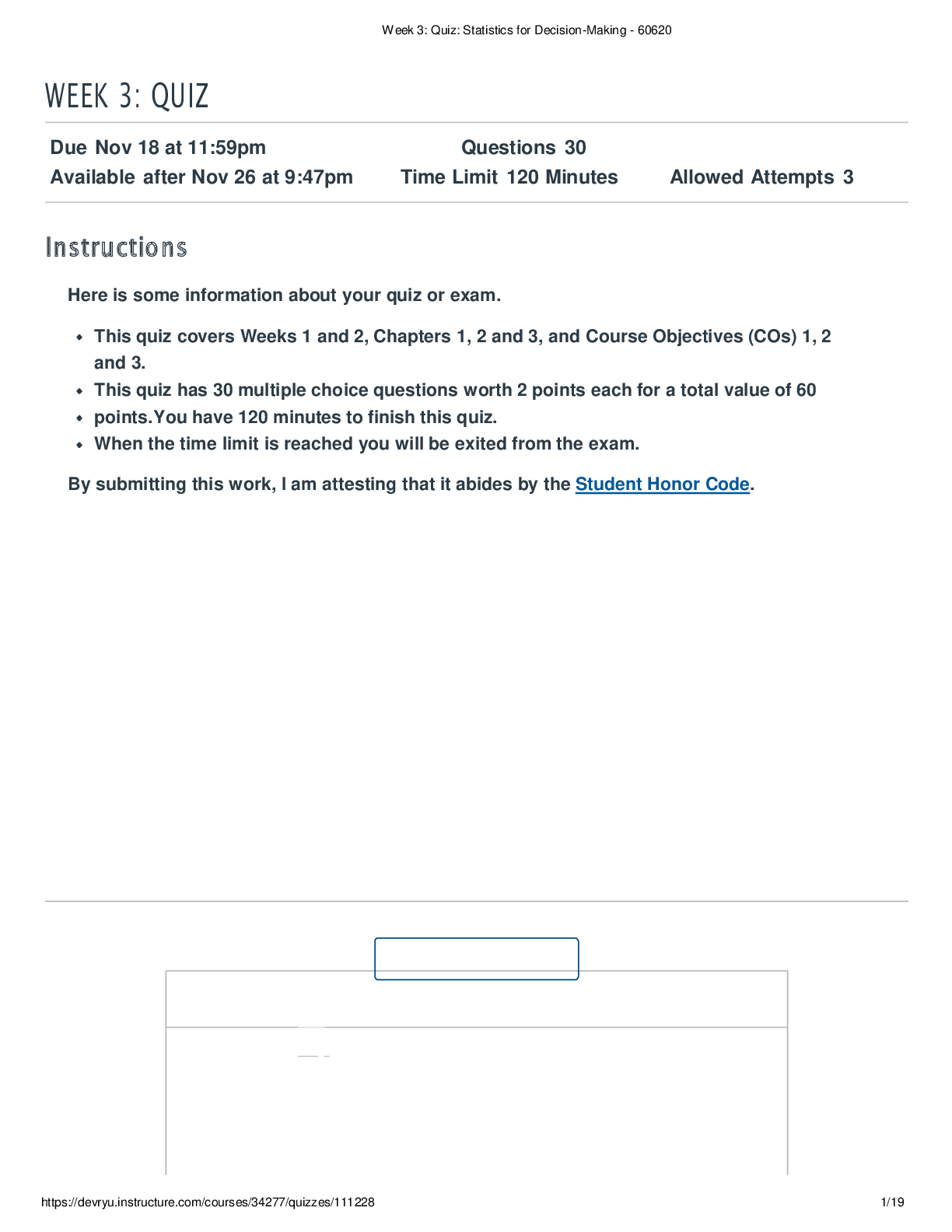

.png)










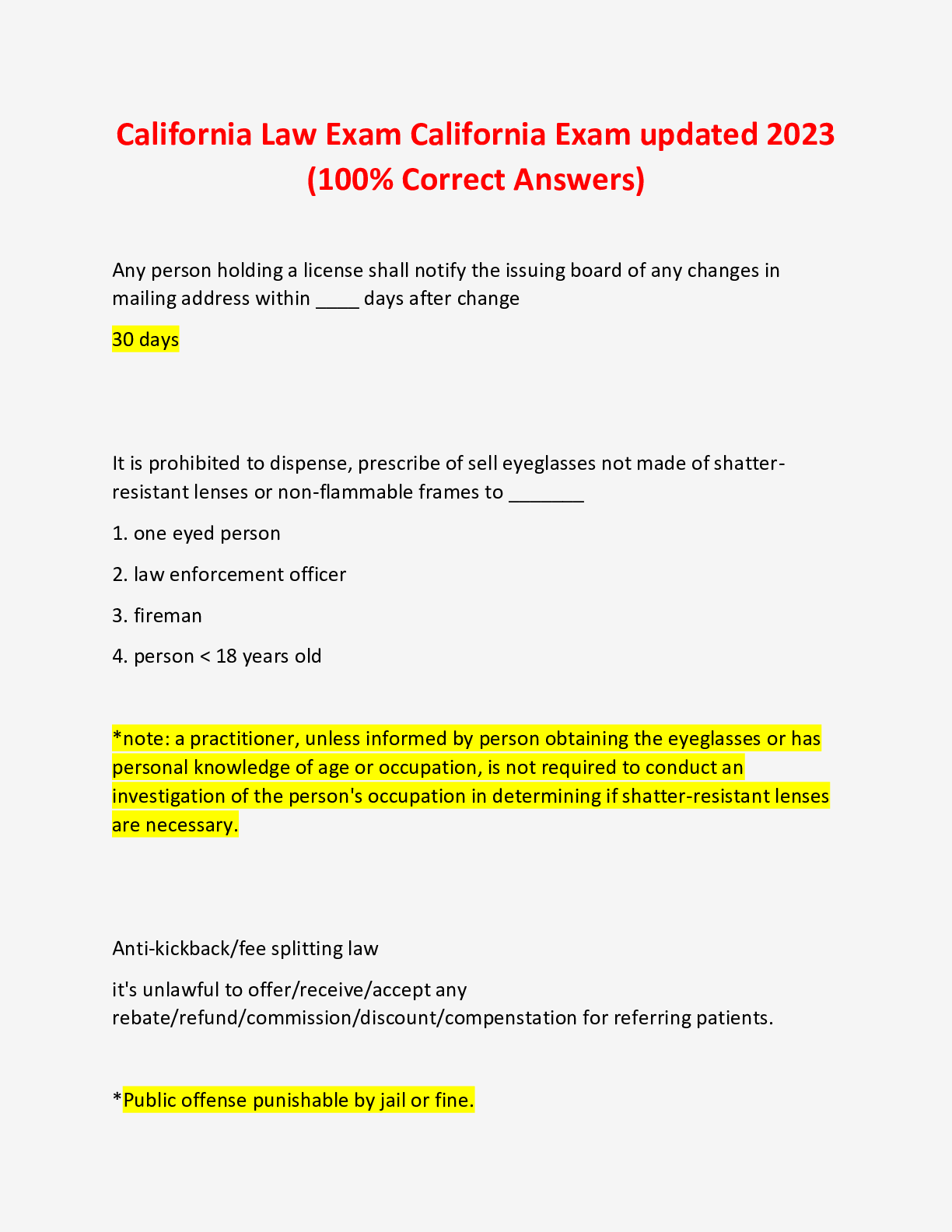


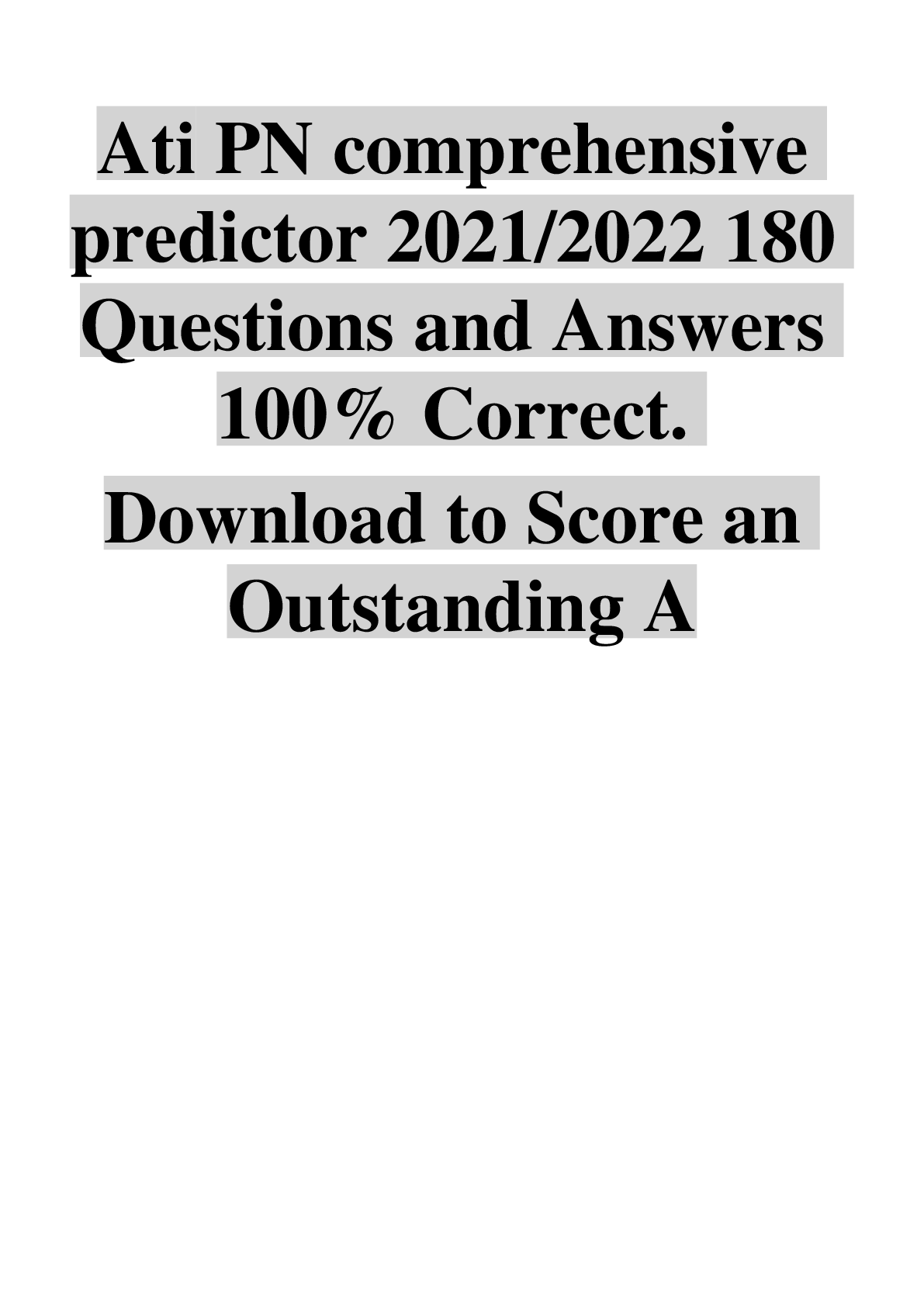

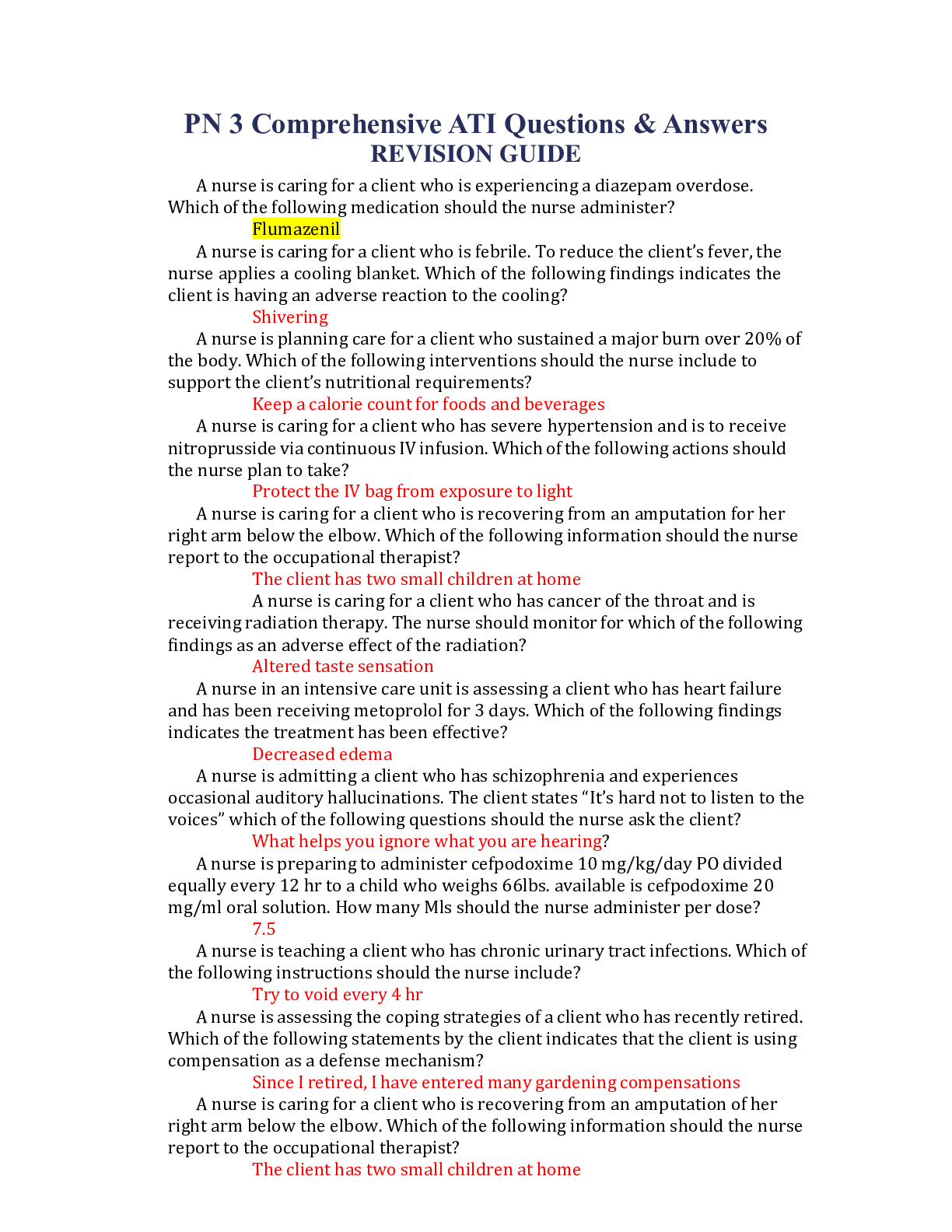
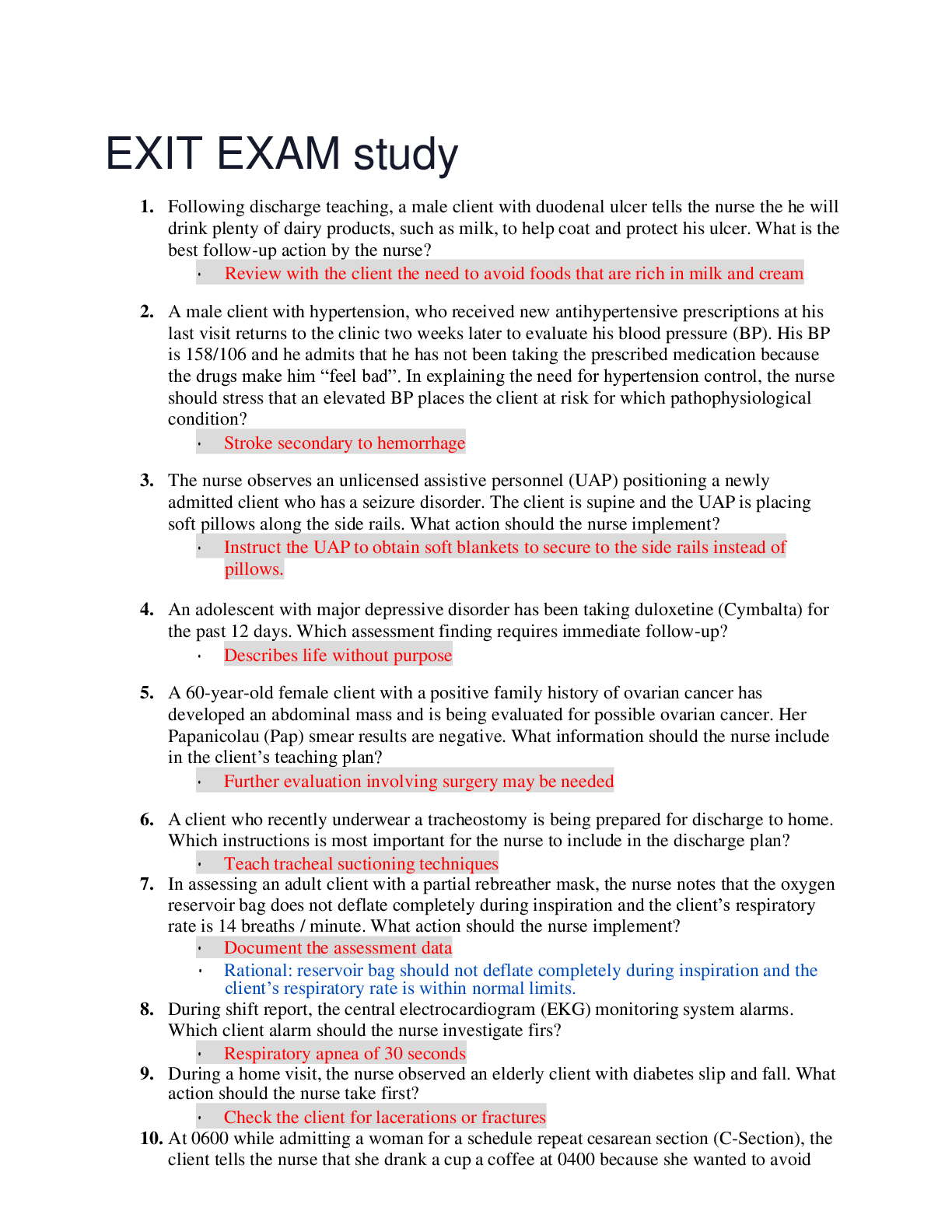
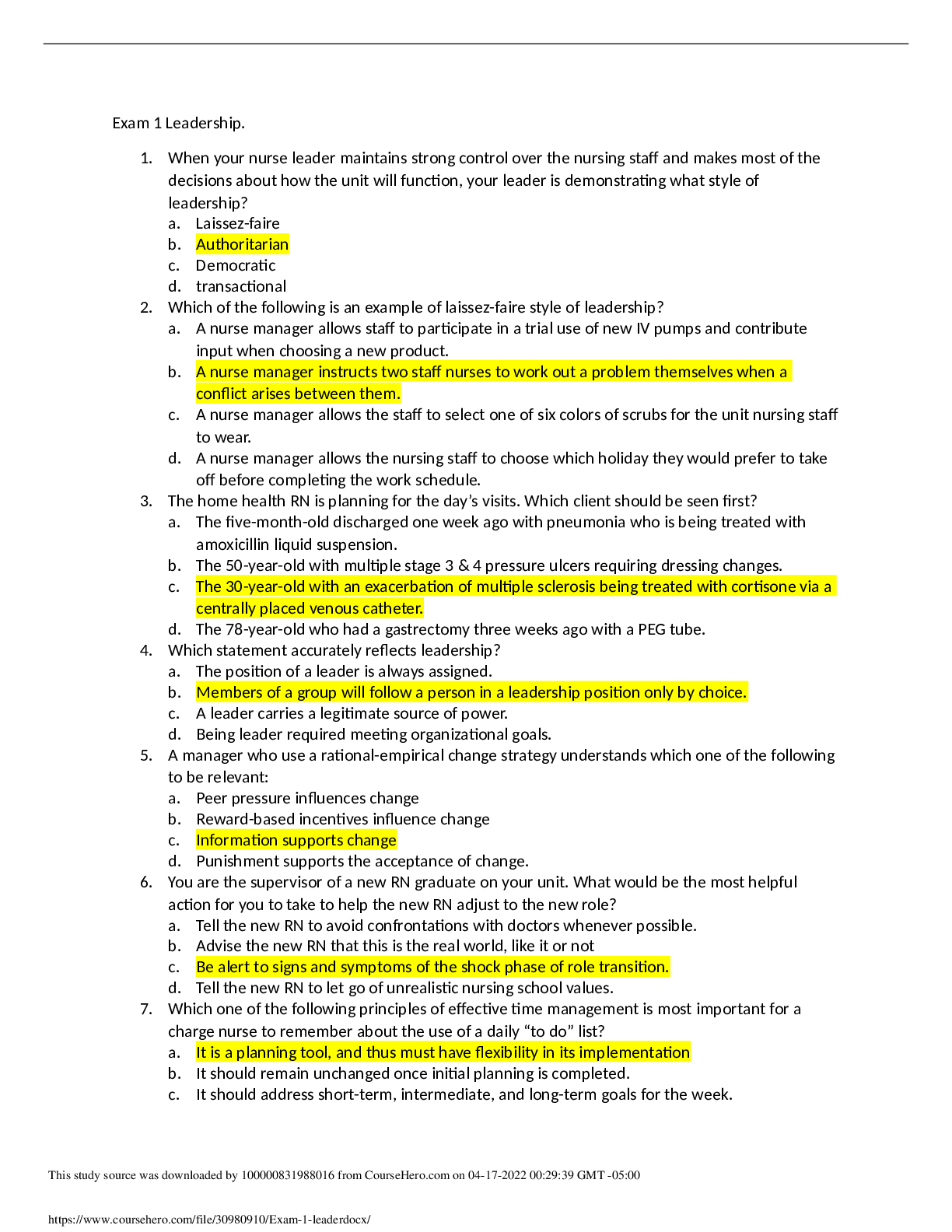
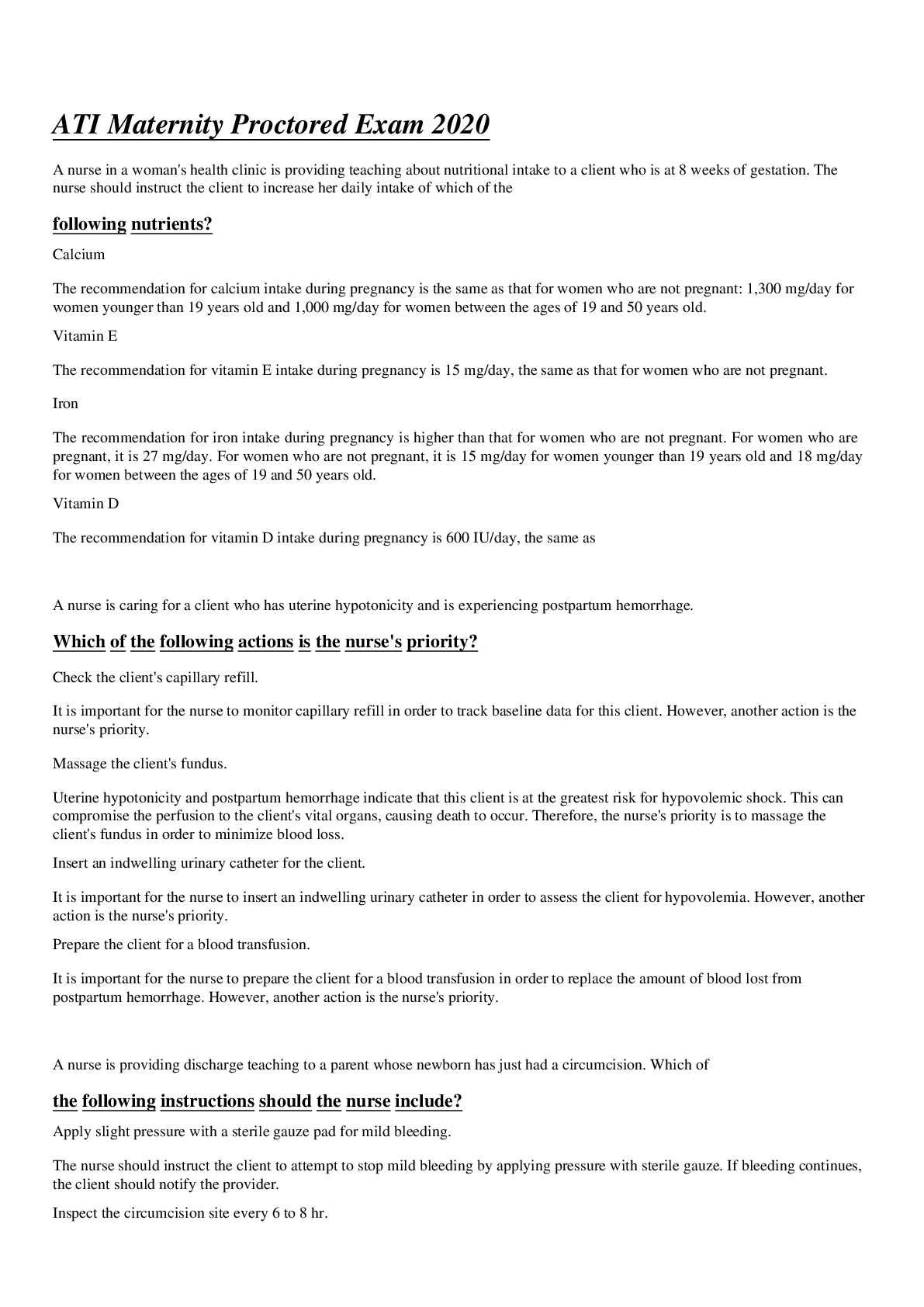
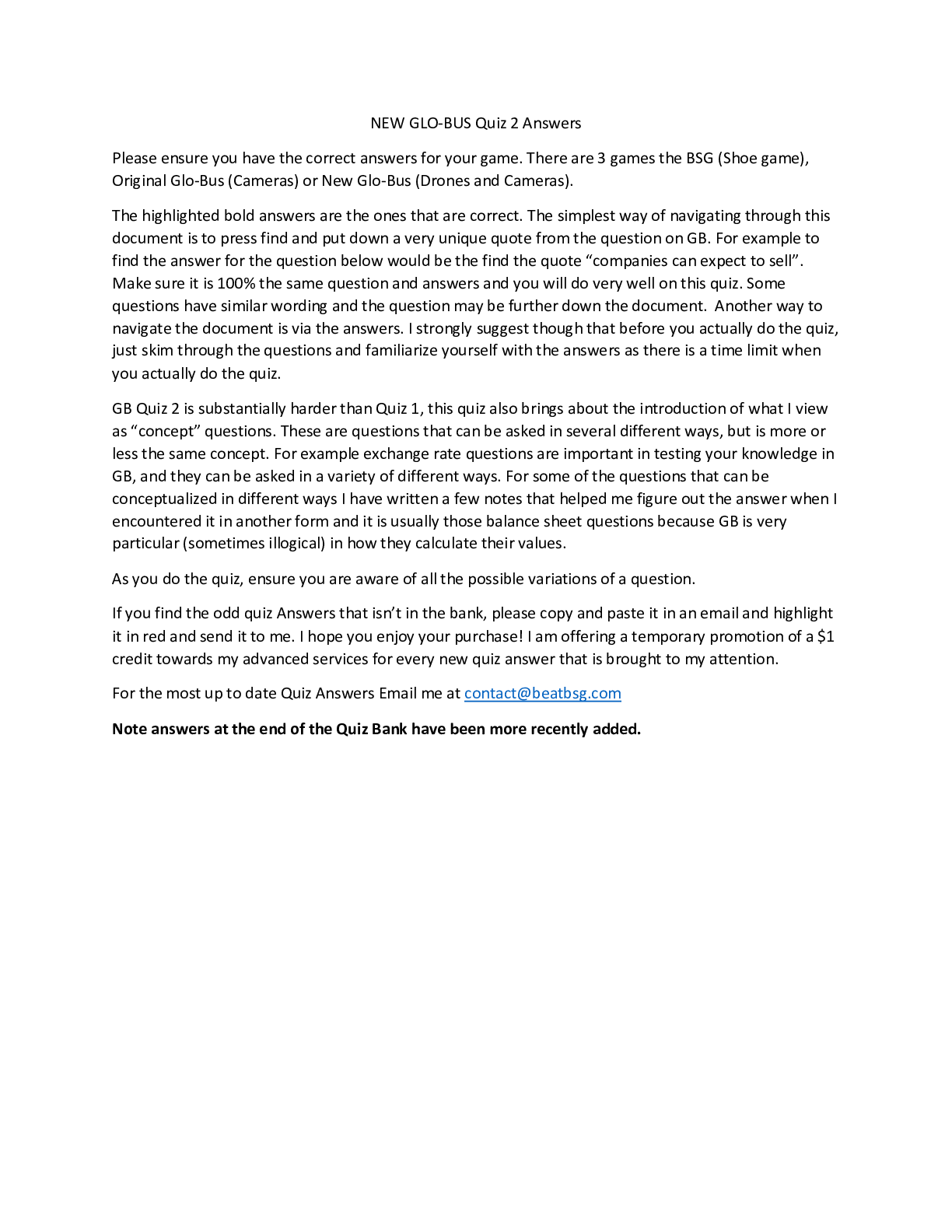
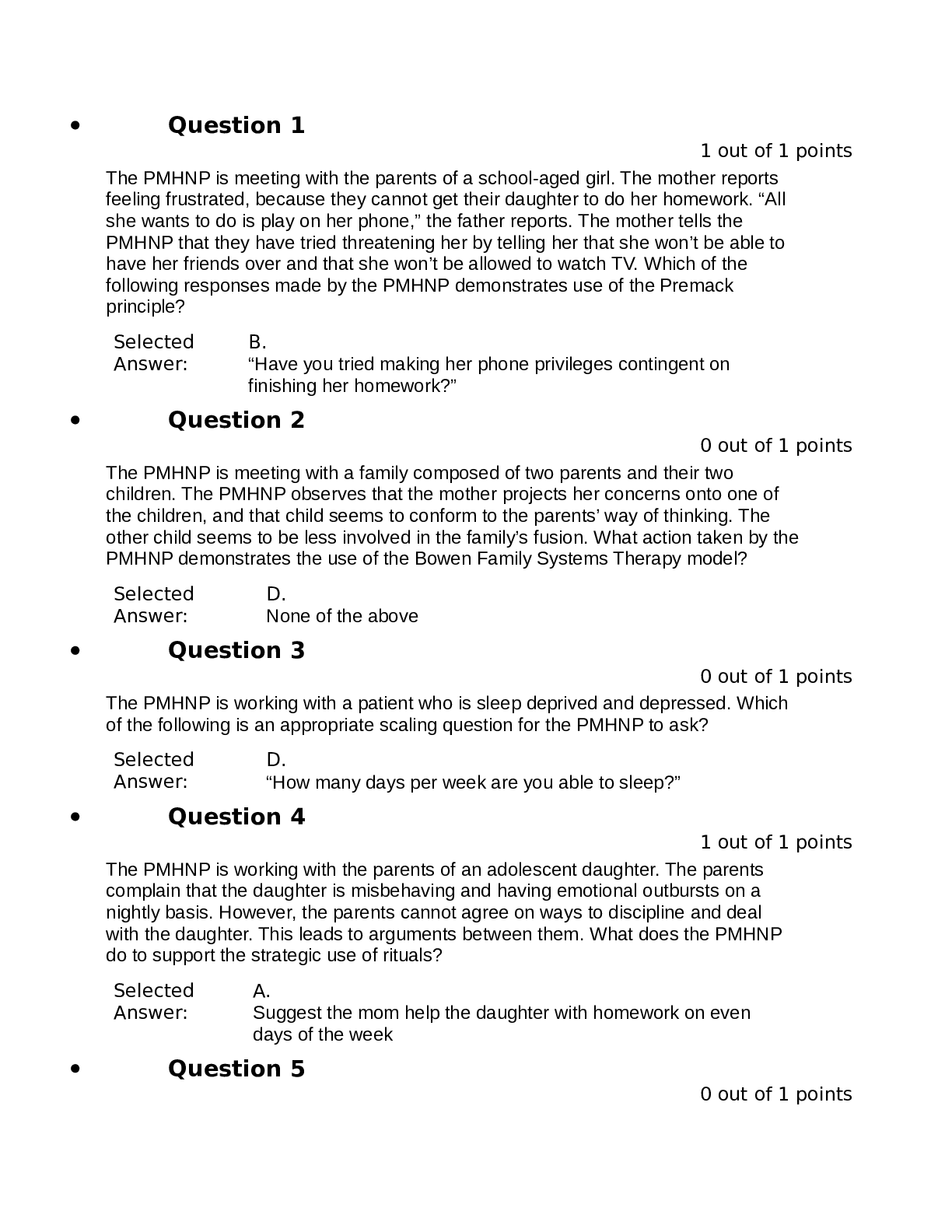
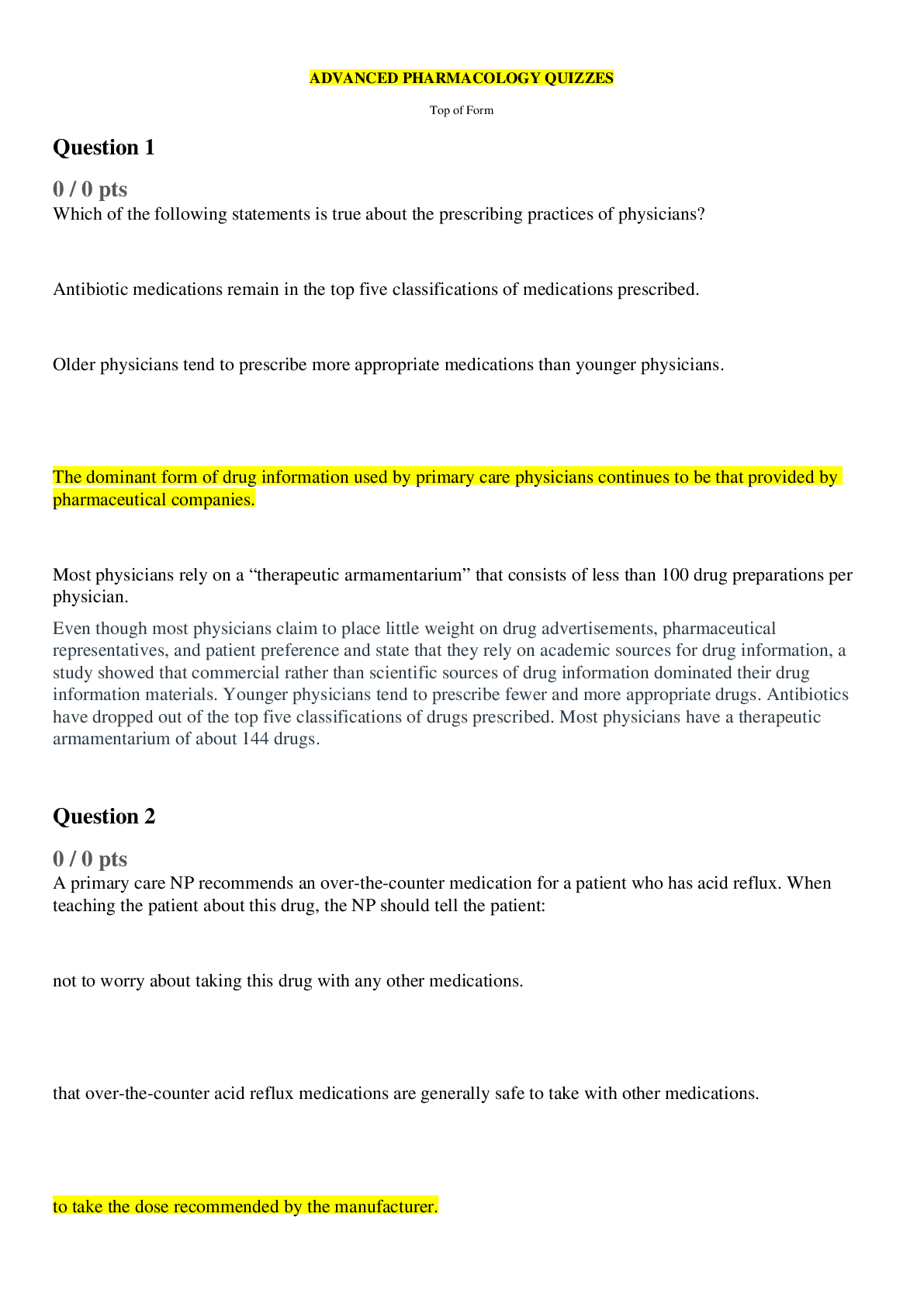
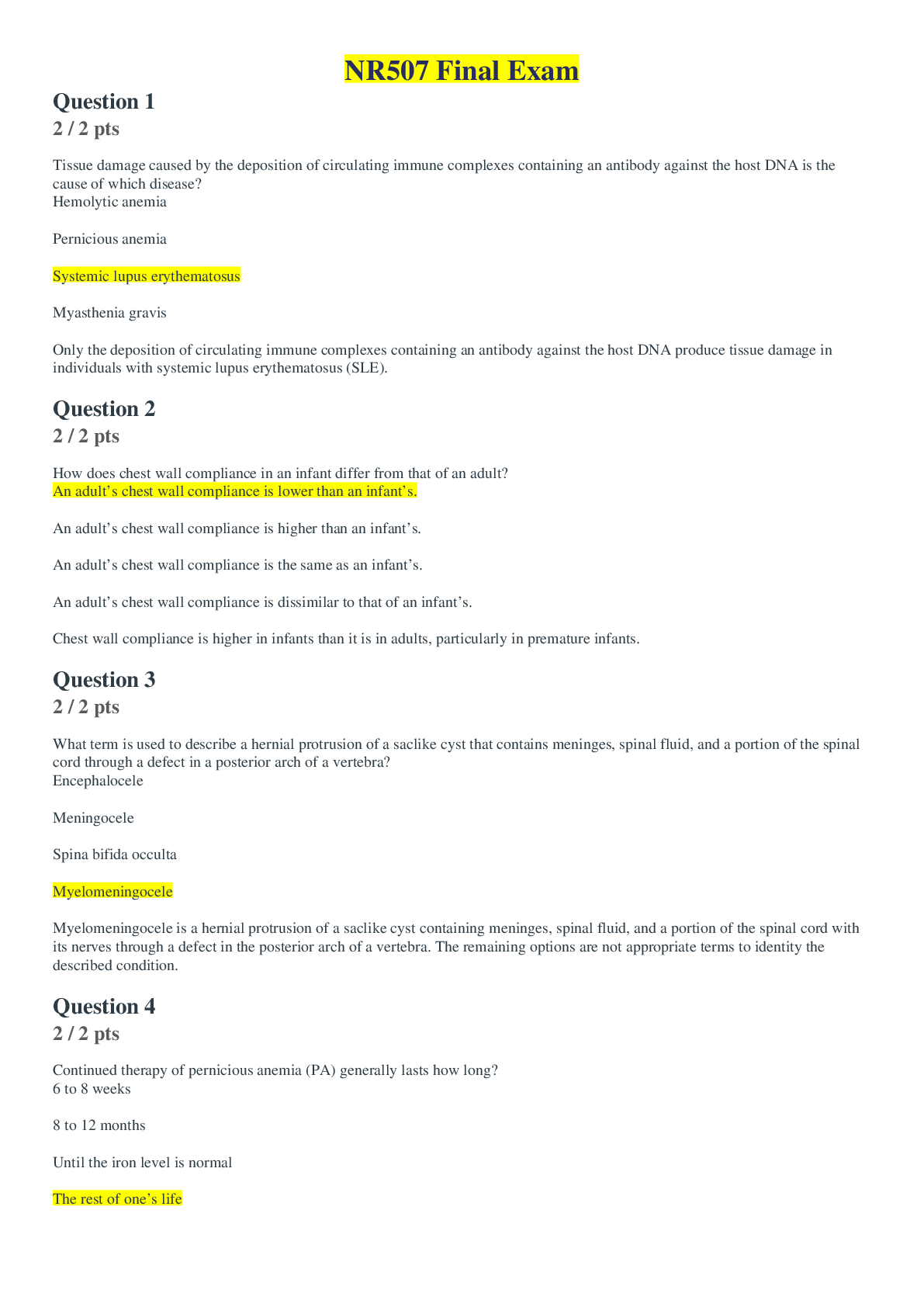
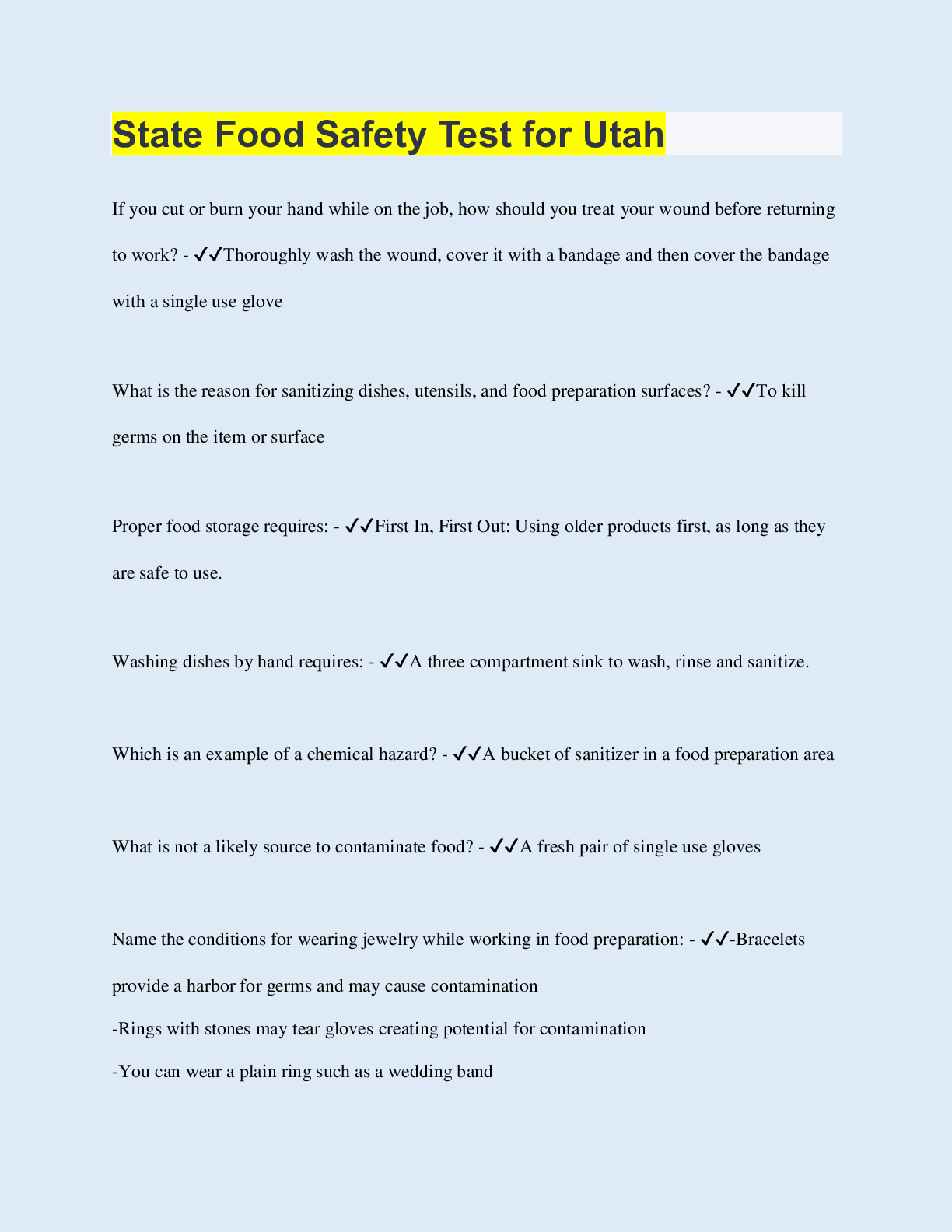
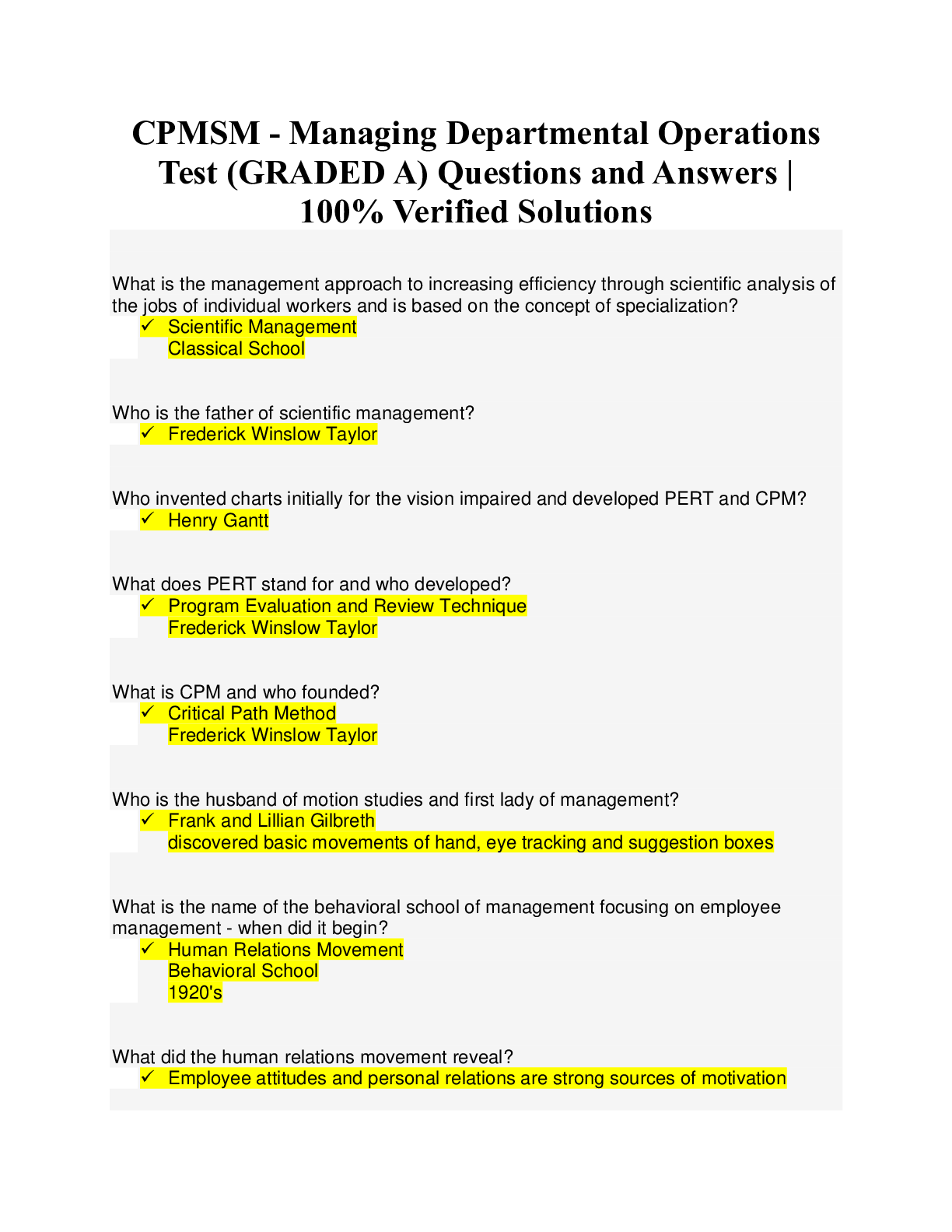
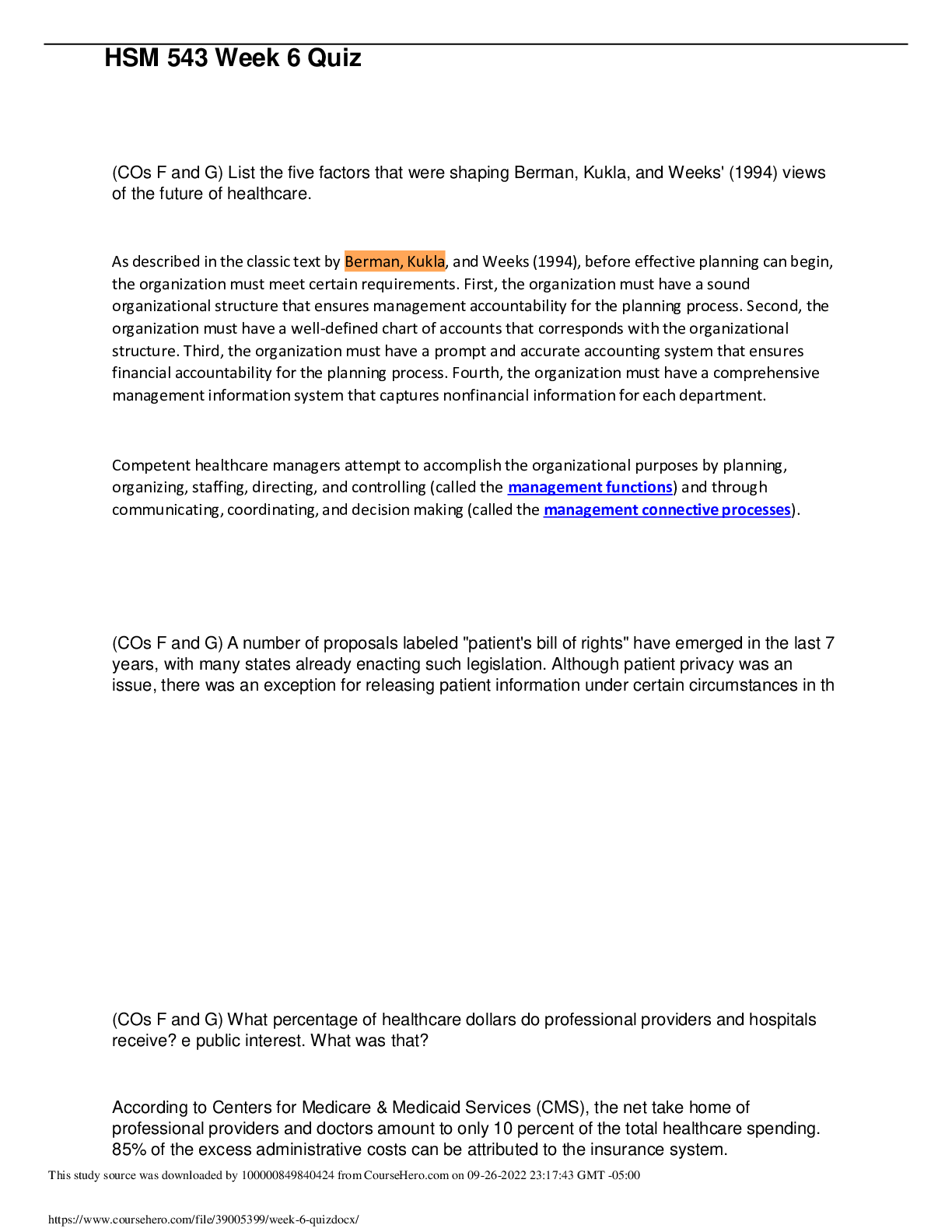
 (1).png)
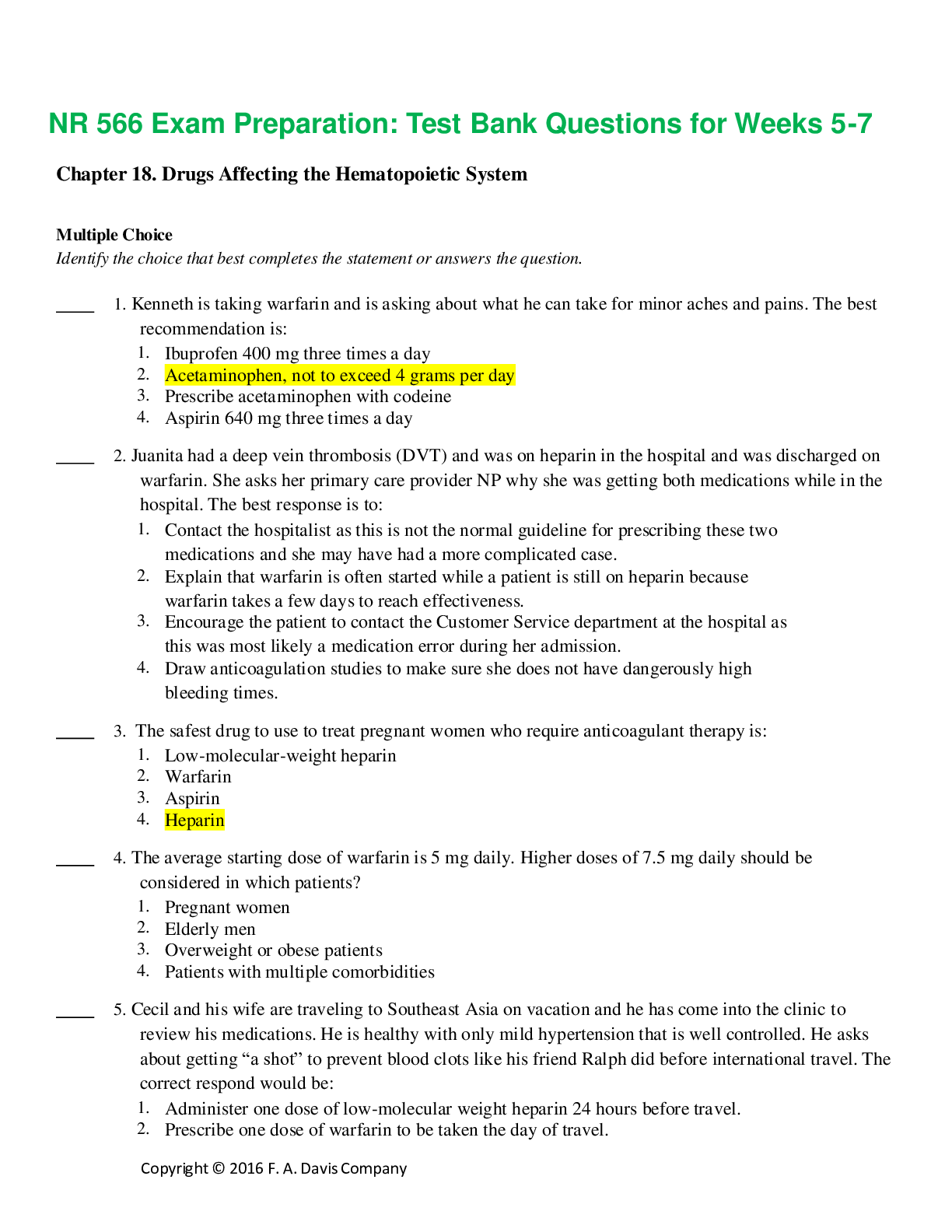
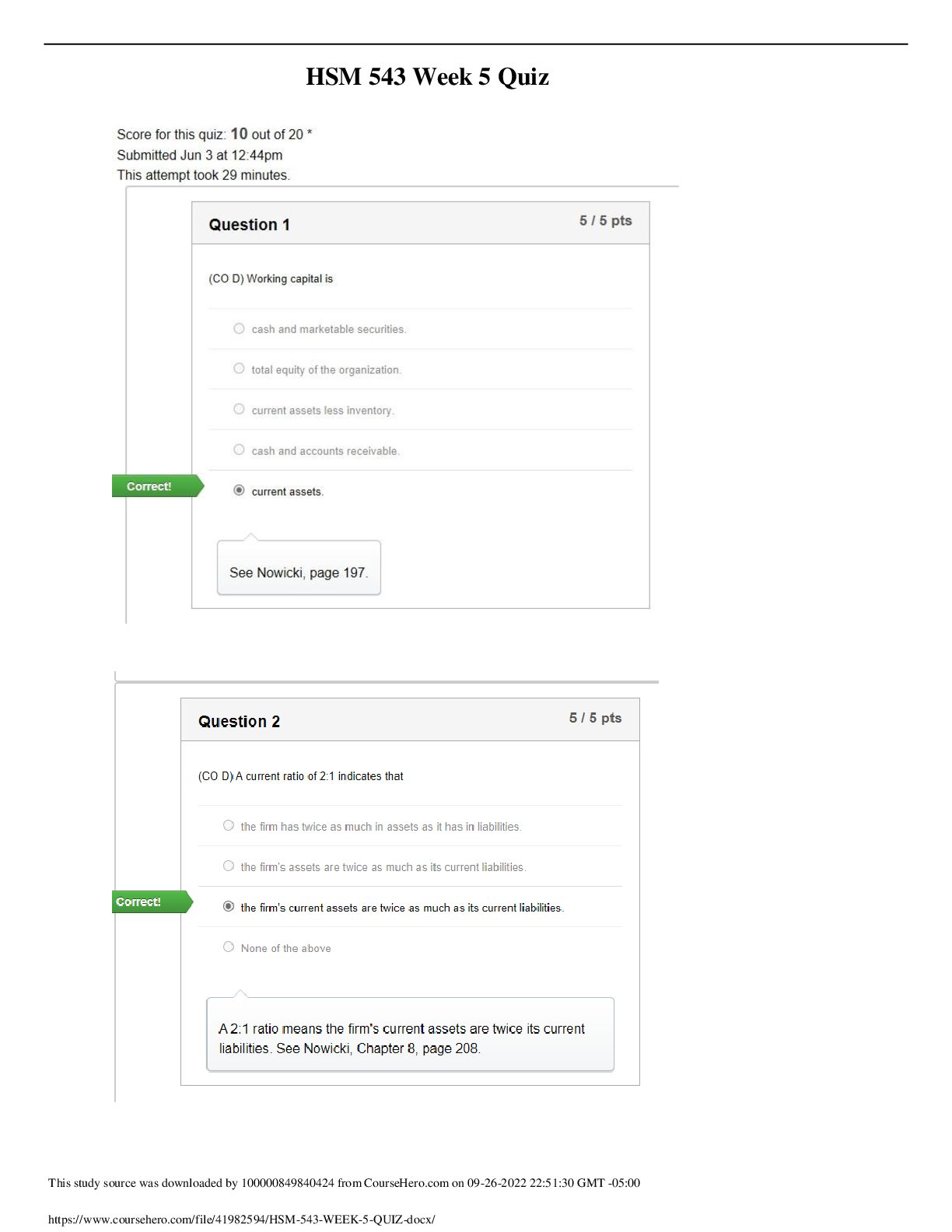
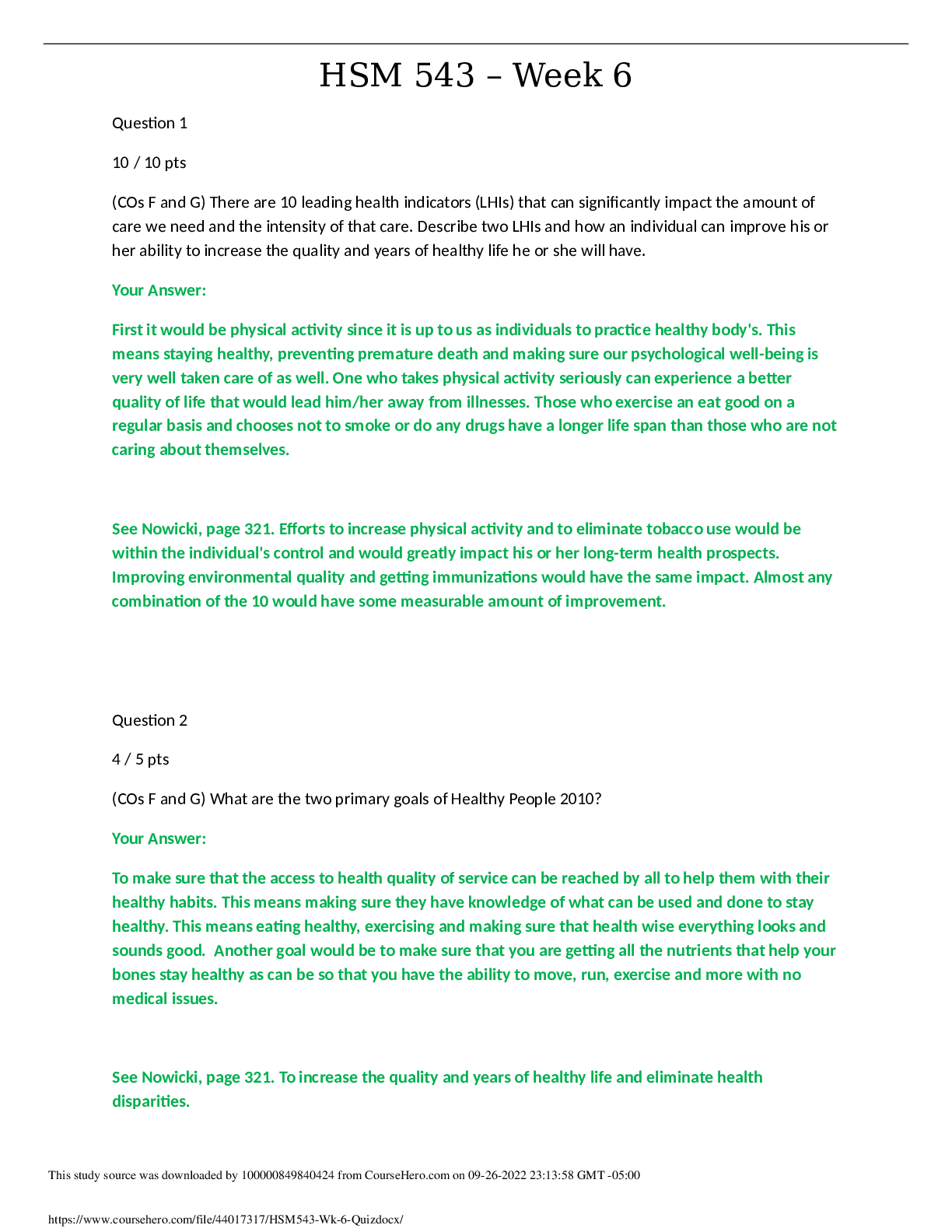
.png)
